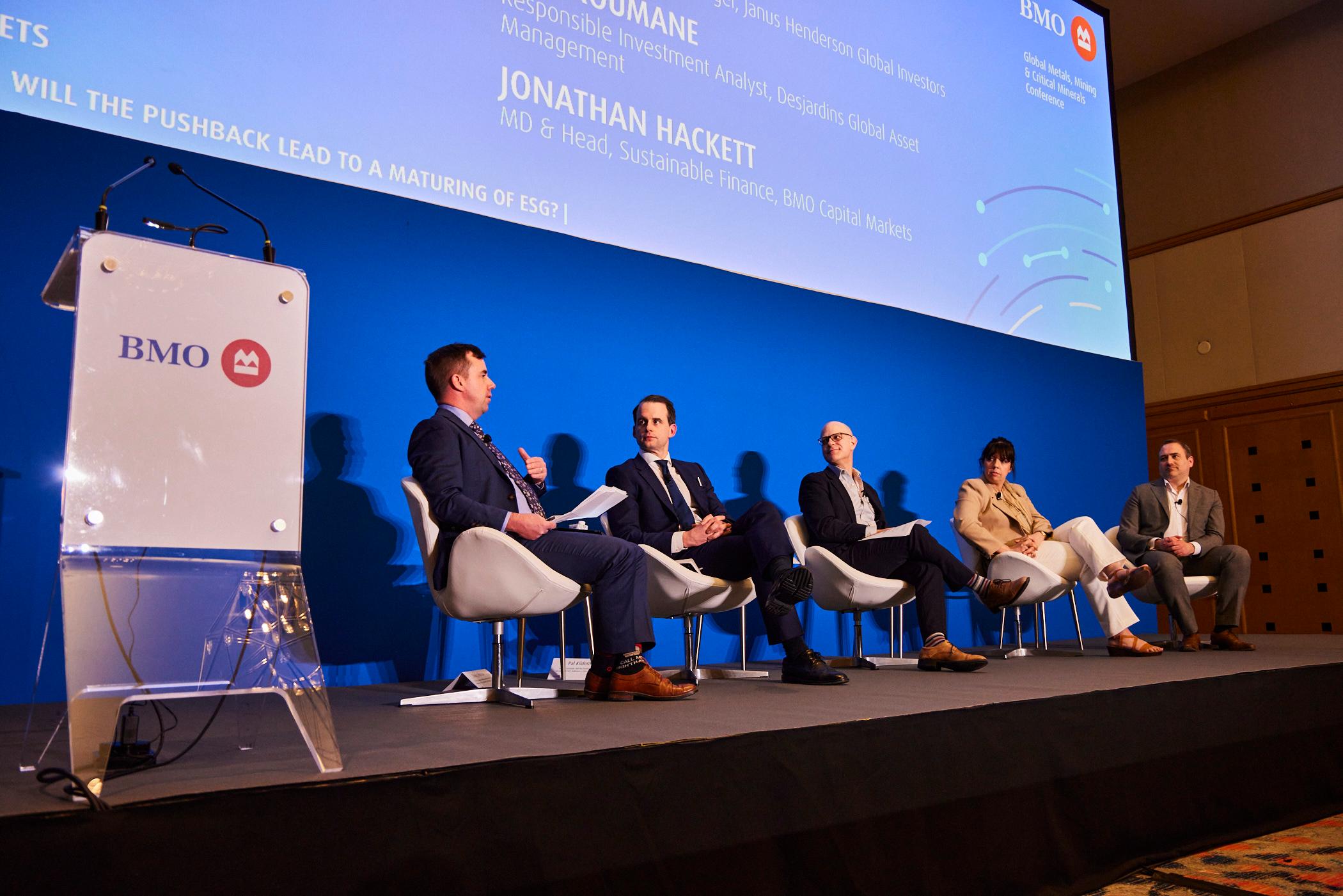Disponible en anglais seulement
The mining industry remains focused on sustainable business practices, even as investment flows into funds dedicated to environmental, social, and governance (ESG) issues slow.
That was one of the many takeaways from “At the Crossroads: Will the Pushback Lead to a Maturing of ESG?” a panel discussion at the BMO Capital Markets 33rd Global Metals, Mining & Critical Minerals Conference. Some politicians and investors, mainly in the United States, have pushed back on the need for sustainability criteria and mandates when it comes to investment funds. Over the past 12 months, 150 pieces of so-called anti-ESG legislation have been proposed in various states, while capital flows into ESG funds have tapered.
Still, sentiment among mining companies and institutional investors is that ESG issues are important, especially from a risk mitigation standpoint.
Moderated by Doug Morrow, Director of ESG Strategy at BMO Capital Markets, the discussion featured Jonathan Hackett, Managing Director and Head of Sustainable Finance at BMO Capital Markets, Pål Kildemo, Executive Vice President and Chief Financial Officer at Norsk Hydro ASA, Tal Lomnitzer, Senior Investment Manager at Janus Henderson Investors, and Lila Roumane, Responsible Investment Analyst at Desjardins Global Asset Management.
Mitigating risk
According to a live audience poll taken at the conference, about 75 percent of respondents said that ESG presents a material financial consideration for the mining industry. That strong number in support of ESG proves that we are at “less of a crossroads and more of a bend in the road,” said Janus Henderson’s Tal Lomnitzer.
However, it may be more appropriate to call ESG “non-financial factors,” he noted. “It’s about investing and avoiding downside, and getting it wrong for an E, S, or G is something that can end up costing you money.”
Lila Roumane from Desjardins said that ESG is a tool used to mitigate risk. “It integrates the financially-material ESG issues which matter to risk and return and is no different than considering interest rate risk,” she said.
BMO’s Jonathan Hackett noted that many people still want to make an impact through their investments, but part of the reason for the pushback is that the labeling of investment products has not always matched the activity that they engaged in. “We had all of these asset managers coming to market saying, ‘Invest with ESG to save the planet.’ But ESG screening is not about saving the planet,” he explained. “It’s about reducing certain risks, making sure businesses incorporate environmental and social factors that are financially material. Investing for the planet is Impact, not ESG.”
Creating value
Clearly, for those on the panel and at the conference, ESG still matters. For Roumane, every mining operation her business invests in is carefully considered through an ESG lens. Given that miners are still significant carbon emitters, it is important for her to see what companies are doing to reduce their environmental risks. That includes looking at their water usage, land use, deforestation, and developing a plan to address climate change, such as a roadmap to net zero.
On the social front, Roumane considers human rights, employee management, how the business builds trust and relationships within its communities, Indigenous relations and much more. “All of these are extremely important in the mining sector,” she said. "The company that loses its license to operate—there is zero value for shareholders at the end, and it’s extremely hard to rebuild."
Companies can quickly lose value if they run into an ESG-related problem, but having a strong track record around these issues may create value, too, explained Hackett. “You have to believe that if you’re using ESG as a proxy for management competence, being really good at fulfilling the obligations and expectations of investors in one dimension is going to help in another.”
It is not yet clear if businesses taking ESG factors into account is reflected in stock prices, he said. That is partly because ESG is a long game, while investors are focused on short-term results. Over time, though, efforts to mitigate risks should boost shareholder value.
“When you expand out to a 30-year time horizon like on a mining asset and can say you have better treatment of your employees, you have better relations with communities, you avoid negative incidents – those negative incidents don’t have an inherent one-year expected frequency. Maybe you avoid an incident once every 10 years – in mining, that’s material.”
Profit from purpose
For Norsk Hydro, which sells low-carbon and recycled aluminum and produces renewable energy, its ESG investments have been the most profitable, said Pål Kildemo. His business started embracing lower-carbon products early, many of which currently command a higher premium, proving yet again that ESG still matters to many investors and customers.
“Our biggest differentiator is that we’re starting to get greener premiums on the products we produce,” he explained. “And it’s not small verification premiums anymore. It’s not like getting $10 to $50 on top of $2,000. That was at the start. Now it’s much more about paying the price of carbon that you’re taking out of the Scope 3 for your customer.”
The importance and priority of ESG factors may currently be up for debate for some. Over the long term, ESG will eventually become a normal part of investing and risk management.
“It’s hard to see a way in which this isn’t fully integrated,” said Hackett. “It’s going to be a new normal and we’ll have sorted out what’s material and what’s not.”
